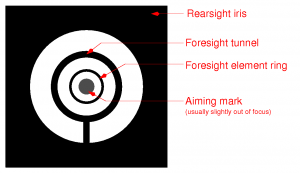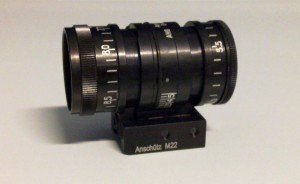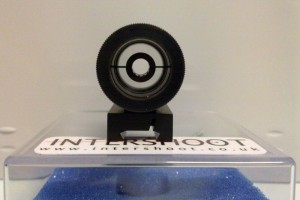Tightening up…
Last night’s training was fairly heartening – after warming up and settling into position, I wound the foresight ring size down to the lowest my foresight would get to (it says 3.8mm, but I think it’s just under that), and found that I could not only hold with that, but hold steadily.
Those of you who shoot know that’s a good thing. For those who don’t, a word of explanation. The sight picture you have when shooting (ie. what you see when you look through the sights) is a bit like this:

The foresight tunnel I’m using is a nice one:


and by ‘nice’ I mean that it allows you to alter not only the cant angle of those bars (which allows you to gauge the cant of the rifle and keep it consistent), but also the diameter of the foresight ring element and its thickness.
Now look at the gap between the ring element and the aiming mark in the sight picture diagram above; the larger the ring element, the larger that gap gets, obviously. What’s less obvious is that as your hold isn’t rock solid (because you’re a human and not a rock), it will look like the aiming mark is moving around in the ring element, and you can wind up subconciously attempting to muscle the rifle around to get things aligned as they are in the diagram above; but your muscles won’t allow you to do that — it’s too fine a motion for them to manage — and you’ll wind up overcontrolling things, and making the wobble even larger and it will continue growing until you’re nowhere even close to on target.
We detect that wobble not by looking at the aiming mark itself though, but the gap between it and the ring element (it’s a funny by-product of how human eyesight works). So if you open up the ring element, make it larger, the aiming mark won’t appear to move so much, you won’t attempt to muscle the rifle about, and you’ll get a more consistent position and thus more consistent shooting (and higher scores). However, there are limits – if the gap’s too big, you can’t judge how centered the aiming mark is, and then while your hold will be better, your aim will be worse and the scores fall off. The optimal amount will be dependant on how good your hold is, and how good your hold is determines your score – strap a shooter into a noptel and most coaches can predict their match score to within a point or three from the data taken from one average shot.
The lower you can get that optimal diameter for the ring element, then, the better your performance in a match will be. In DURC, we would usually start training people on a very large foresight – 4.5mm at the very least, 5.0mm if we could manage to find an element. And normally I’d train around the 4.2-4.5 range myself. Matt has me dialling it down as far as it’ll go at the moment though, so that we can see how good the hold is getting. I was expecting that at about 4.0 the hold would start getting shaky – but we managed to wind it down as far as the sights would take us (3.8ish) and no wobble spotted by then. I think we could have gone down as low as 3.6 before we’d have hit problems.
That’s a pretty nice feeling 🙂
(We won’t be shooting a match at 3.8 though, that’d be a bit silly. It’s a training exercise, not a match setup. For matches, somewhere between 4.0mm and 4.4mm would be right, depending on the range’s lighting and other factors).
Leave a Reply